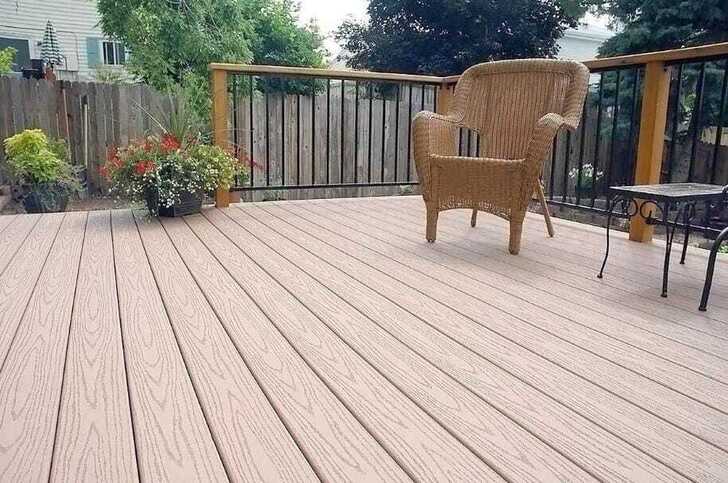Nowadays, almost every builder has composite decking for sale in a variety of styles and colors. Traditional wood decking is now widely seen as the last cheap option. Traditional wood decks have a short lifespan, though, as they rot quickly. However, before purchasing composite decking for your next decking project, you should first understand the disadvantages of composite decking.
Composite decks have four main drawbacks:
Composite decks can fade from sun exposure
Composite decks can warp in hot weather
Composite decks can wear out in high traffic areas
Composite decking can rot and become unsafe (the biggest concern)
So, you may ask, why are composite boards still being sold? Let's go back to the beginning of decking and we'll explain how it all happened.
The Origin of the Decking Story:
Back in the early 1980s, people began using traditional wood decks as a cost-effective and efficient way to create clean and tidy outdoor living spaces. Inspired by similar uses on boats, some homeowners began using the same style of wood decking on their homes. Traditional wood decks are costly to install and easily damaged. And it can add to the complexity of a project when dealing with gutters and uneven ground.
The idea of installing a wood deck on top of all these irregularities and challenges was novel at the time. It meant that the outdoor space could be completed quickly. After installation the deck is completely flat and looks very clean and tidy. Not only that, but it was installed at a fraction of the cost of a traditional deck installation.
However, despite continually improving pressure treatments to help protect wood decking. However, homeowners quickly realized that wood decks were still rotting rapidly. Not only does this make outdoor spaces look old and worn, but it can also pose a safety risk due to damaged boards.
As the deck was used over time, a more serious problem became more apparent. As water drips down through the gaps between the wooden decking and onto the wooden joists, the joists also begin to rot and become damaged. This meant that the entire structure could become unsafe and usually had to be replaced within a few years.
Today, the expenses associated with this kind of accidental damage are still overwhelming for many people. That's why many homeowners try to save money initially by opting for cheaper wood flooring. Only to find that the cost of maintenance and replacement comes faster and is greater than expected.
Is Composite decking the perfect solution?
Composite decking only solves a small portion of these problems, while the more important issues have yet to be addressed. These decking issues are now becoming more and more apparent.Composite boards are usually made from a mixture of wood and plastic and molded into a floor. This is a very durable and long-lasting new material that offers many more advantages. If you're considering using composite decking to complete your project, it's a no-brainer investment. And you want to make sure it will last! Sure, most manufacturers will tell you it lasts a long time, won't rot, etc. ...... This is true. However, you should also realize that composite deck has the following important issues.
Below we have listed common problems with composite decks and how to avoid them.
Decks can fade due to sunlight exposure
Many colored plastic products have problems with fading when exposed to sunlight. This means that your composite decking may begin to look old and worn over time with use. This can affect the overall appearance of your home and make your outdoor space less aesthetically pleasing.
Composite decking can buckle in hot weather
As you might expect, any plastic material will soften when the weather gets hot. While plastic has good water resistance, composite will buckle and warp in hot weather and prolonged sun exposure. And composite decking can get very hot during the hot season, which can make it difficult to walk.
Composite boards wear out in high traffic areas
The surface of composite decking usually has a decorative pattern. But as you can imagine, the plastic on the surface of the decking is usually very soft and therefore prone to wear and tear. Even if the plastic is mixed with wood, the decking surface is usually plastic. This means that any wear patches in high-traffic areas will look very unsightly. For this reason, it's important to check the abrasion resistance of the deck you plan to use.
Not to worry though, many manufacturers have already identified this problem. As a result some manufacturers have started producing more hard-wearing composite decks which are covered with a protective layer.
Wooden frames rotting and becoming unsafe
Think about it, all the rainwater that falls on a deck has to go somewhere. Rainwater can drip between decks and into the bottom framing structure. The deck is supported by wooden joists, and prolonged wet conditions can slowly rot them. This is a silent, invisible but very dangerous and costly damage.
So, should a composite deck be secured to expensive aluminum joists? No. Aluminum joists are so costly that they are completely unnecessary. By simply purchasing the right decking system, you can save money by using traditional wood joists. The cost of using regular wood framing is much lower. Overall, wood joists cost less and last longer.
Website of Source: https://www.evodek.es/
Source: Story.KISSPR.com
Release ID: 1050628

